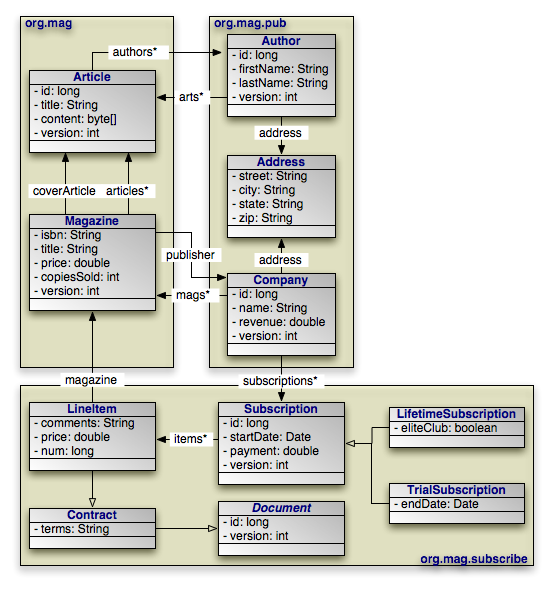Table of Contents
Object-relational mapping is the process of mapping entities to relational database tables. In JPA, you perform object/relational mapping through mapping metadata. Mapping metadata uses annotations to describe how to link your object model to your relational model.
Note
OpenJPA offers tools to automate mapping and schema creation. See Chapter 7, Mapping in the Reference Guide.
Throughout this chapter, we will draw on the object model introduced in Chapter 5, Metadata . We present that model again below. As we discuss various aspects of mapping metadata, we will zoom in on specific areas of the model and show how we map the object layer to the relational layer.
 |
All mapping metadata is optional. Where no explicit mapping metadata is given, JPA uses the defaults defined by the specification. As we present each mapping throughout this chapter, we also describe the defaults that apply when the mapping is absent.
Note
Mapping metadata is used primarily with schema generation. This metadata should not be relied upon for validation prior to communicating with the database. For example using the @Column(nullable=false) annotation does not do up front validation that the value in the entity is correct.
The Table annotation specifies the table for an entity
class. If you omit the Table annotation, base entity
classes default to a table with their unqualified class name. The default table
of an entity subclass depends on the inheritance strategy, as you will see in
Section 6, “
Inheritance
”.
Tables have the following properties:
String name: The name of the table. Defaults to the unqualified entity class name.String schema: The table's schema. If you do not name a schema, JPA uses the default schema for the database connection.String catalog: The table's catalog. If you do not name a catalog, JPA uses the default catalog for the database connection.UniqueConstraint[] uniqueConstraints: An array of unique constraints to place on the table. We cover unique constraints below. Defaults to an empty array.
The equivalent XML element is table. It has the following
attributes, which correspond to the annotation properties above:
nameschemacatalog
The table element also accepts nested
unique-constraint elements representing unique constraints. We will
detail unique constraints shortly.
Sometimes, some of the fields in a class are mapped to secondary tables. In that
case, use the class' Table annotation to name what you
consider the class' primary table. Later, we will see how to map certain fields
to other tables.
The example below maps classes to tables to separate schemas. The
CONTRACT, SUB, and LINE_ITEM
tables are in the CNTRCT schema; all other tables
are in the default schema.
Example 13.1. Mapping Classes
package org.mag;
@Entity
@IdClass(Magazine.MagazineId.class)
@Table(name="MAG")
public class Magazine {
...
public static class MagazineId {
...
}
}
@Entity
@Table(name="ART")
public class Article {
...
}
package org.mag.pub;
@Entity
@Table(name="COMP")
public class Company {
...
}
@Entity
@Table(name="AUTH")
public class Author {
...
}
@Embeddable
public class Address {
...
}
package org.mag.subscribe;
@MappedSuperclass
public abstract class Document {
...
}
@Entity
@Table(schema="CNTRCT")
public class Contract
extends Document {
...
}
@Entity
@Table(name="SUB", schema="CNTRCT")
public class Subscription {
...
@Entity
@Table(name="LINE_ITEM", schema="CNTRCT")
public static class LineItem
extends Contract {
...
}
}
@Entity(name="Lifetime")
public class LifetimeSubscription
extends Subscription {
...
}
@Entity(name="Trial")
public class TrialSubscription
extends Subscription {
...
}
The same mapping information expressed in XML:
<entity-mappings xmlns="http://java.sun.com/xml/ns/persistence/orm"
xmlns:xsi="http://www.w3.org/2001/XMLSchema-instance"
xsi:schemaLocation="http://java.sun.com/xml/ns/persistence/orm orm_1_0.xsd"
version="1.0">
<mapped-superclass class="org.mag.subscribe.Document">
...
</mapped-superclass>
<entity class="org.mag.Magazine">
<table name="MAG"/>
<id-class="org.mag.Magazine.MagazineId"/>
...
</entity>
<entity class="org.mag.Article">
<table name="ART"/>
...
</entity>
<entity class="org.mag.pub.Company">
<table name="COMP"/>
...
</entity>
<entity class="org.mag.pub.Author">
<table name="AUTH"/>
...
</entity>
<entity class="org.mag.subcribe.Contract">
<table schema="CNTRCT"/>
...
</entity>
<entity class="org.mag.subcribe.Subscription">
<table name="SUB" schema="CNTRCT"/>
...
</entity>
<entity class="org.mag.subscribe.Subscription.LineItem">
<table name="LINE_ITEM" schema="CNTRCT"/>
...
</entity>
<entity class="org.mag.subscribe.LifetimeSubscription" name="Lifetime">
...
</entity>
<entity class="org.mag.subscribe.TrialSubscription" name="Trial">
...
</entity>
<embeddable class="org.mag.pub.Address">
...
</embeddable>
</entity-mappings>